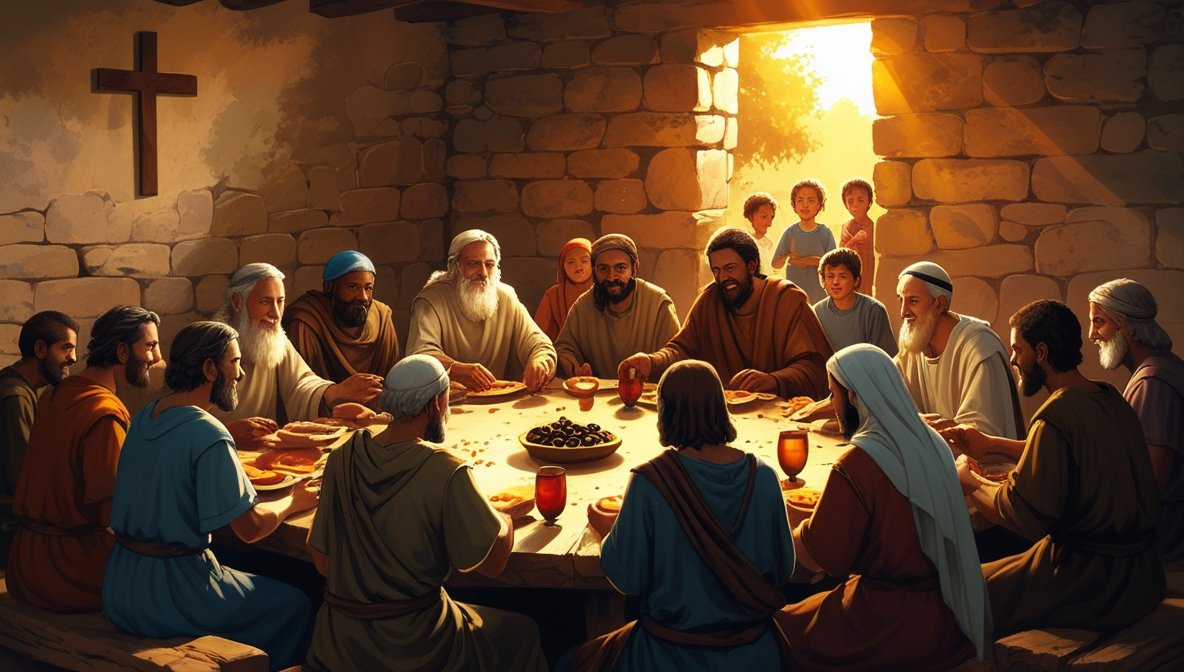Fellowship In The Early Church: A Model For Us Today
When you read the story of the early Christians, you see more than history — you see a living example of what community can look like when people are committed to following Jesus together. That commitment we often summarize as “fellowship in the early church” is more than warm feelings or occasional potlucks. It’s a pattern of shared life that includes teaching, prayer, worship, generosity, and radical unity. If you want to see the church not just survive but thrive in your neighborhood, workplace, or online group, the practices of the first believers deserve your attention. This article will walk you through the biblical picture, unpack lessons you can apply right now, and offer practical steps for building an authentic community that reflects the gospel.
What Acts 2:42-47 Actually Says
Start here: read the passage that most directly describes the early church’s communal life. In Acts 2:42-47 you read about a group of people devoted to four things — the apostles’ teaching, fellowship, the breaking of bread, and prayer — and you see their life characterized by awe, generosity, and growth. Take a moment to read it in context: Acts 2:42-47. When you look carefully, you discover that the early church’s practices were intentional and spiritual at once; they were shaped by theology and expressed in everyday choices.
Focusing on this passage helps you understand what “fellowship in the early church” meant practically. It wasn’t a vague sentiment. These believers met regularly, learned together, prayed together, ate together, and shared possessions where necessary so that no one had need. That combination of devotion, relational depth, and material generosity gave them a credible witness that attracted others to the faith. If you want to emulate their model, you need to see both the spiritual and the practical dimensions.
Reading the passage with fresh eyes
When you read Acts 2:42-47, notice the verbs: they devoted themselves, they met, they broke bread, they praised God, and the Lord added to their number daily. Those verbs indicate sustained, consistent action rather than one-off events. For you, that means fellowship as a lifestyle rather than a program. The early church modeled rhythms you can adopt: regular teaching, habitual prayer, shared meals, and intentional care for one another.
The Four Pillars You Can Borrow
The phrase “fellowship in the early church” often brings you to four foundational practices: teaching (apostles’ doctrine), fellowship (koinonia), breaking of bread, and prayer. You can’t separate these without losing the full picture. Each pillar supports the others, creating a balanced and resilient community.
Teaching: grounding your community in the Word
The early believers were devoted to the apostles’ teaching, which grounded them in truth and shaped their identity. When you prioritize faithful teaching in your context — whether that’s through scripture-based sermons, small group studies, or consistent discipleship conversations — you help people grow spiritually and stay rooted in Jesus. The early church’s commitment shows that doctrine wasn’t an abstract exercise; it was the bedrock for how they lived together.
Fellowship (koinonia): sharing life, not just information
The Greek word most often translated as “fellowship” is koinonia, which carries the idea of sharing in common. This isn’t just attendance; it’s mutual participation in each other’s lives. For you, fellowship in the early church means making room for vulnerability, celebrating milestones, and carrying one another’s burdens. When fellowship becomes deep, it changes the calculus of how you spend time, money, and energy.
Breaking of bread: the simple power of shared meals
Breaking bread had both sacramental and communal significance. The Lord’s Supper unified belief, while everyday meals deepened relationships. If you want to practice fellowship in the early church today, start by sharing tables. Meals erode barriers, create space for storytelling, and naturally lead to sacrificial generosity. You can’t manufacture the intimacy of a shared meal through a livestream alone, but you can use digital connection to facilitate real-life gatherings.
Prayer: the engine of reliance and witness
The early church prayed together frequently, and prayer shaped their identity and courage. Prayer is more than a spiritual exercise; it’s how you anchor hope, confess wrongs, and ask God to do the impossible. When your group prays regularly, you build a culture that depends on God’s power rather than human effort. Prayer also aligns hearts and fuels unity, two qualities central to fellowship in the early church.
Why Fellowship in the Early Church Mattered
You might wonder: why did these practices matter so much? Beyond personal piety, fellowship in the early church was a powerful evangelistic testimony and a means of grace that sustained believers through persecution, poverty, and rapid growth. Acts shows that their unity and common life attracted outsiders and caused the Lord to add to their number.
Community as a witness
The communal life described in Acts wasn’t just inward-looking. It served as a public witness to the transforming power of the gospel. When people saw believers loving one another and sharing resources, they saw something different from the surrounding culture. That contrast was inviting and contributed to the numerical and spiritual growth of the church.
Practical care for physical and spiritual needs
Fellowship wasn’t merely symbolic; it met real needs. Early Christians shared possessions and made sure no one lacked necessities. Acts 4:32-35 records that “no one claimed that any of their possessions was their own, but they shared everything they had” (Acts 4:32-35). That kind of generosity flowed from a theological conviction: everyone belonged to a new family in Christ. For you, that means fellowship should be measured by how the vulnerable are cared for, not how many events you host.

What Fellowship Looked Like Practically in Acts
When you zoom in on the Acts narrative, fellowship in the early church was concrete. It involved regular gatherings, shared meals, prayer meetings, worship, teaching, and hands-on assistance. The believers met in homes and in public spaces; they ate together, prayed together, and celebrated together. Their life had rhythm and texture that you can emulate.
Meals, homes, and hospitality
Acts notes that believers met in homes and shared meals frequently, often beginning the day together with praise (Acts 2:46). Hospitality was central. For you, hospitality might look like inviting neighbors to dinner, opening your living room for a small group, or being a regular presence in someone’s life. Hospitality builds trust and gives you the relational bandwidth to speak truth in love when hard things happen.
Generosity and economic sharing
The early church’s economic sharing wasn’t a forced communism, but it was extraordinary generosity. People sold property and laid the proceeds at the apostles’ feet to be distributed as needed. That kind of sacrificial giving flowed from a deep conviction that the community belonged to God. You can practice this by prioritizing needy members, supporting local ministries, and being transparent about resources in your group.
Public worship and private care
Fellowship in the early church blended corporate worship with personal care. They prayed publicly and privately, they sang praises together, and they did the hard work of caring for widows and the poor. For you, that means building rhythms that include both liturgical or corporate moments and smaller spaces for intimate care and accountability.
Core Lessons for You Today
If you’re serious about applying “fellowship in the early church” to your life, focus on a few core lessons the New Testament repeatedly emphasizes: unity without uniformity, mutual care, spiritual gifts used for the common good, humility in service, and the centrality of prayer and teaching.
Prioritize gathering, not just information consumption
Hebrews 10:24-25 encourages you not to neglect meeting together, “but encouraging one another” (Hebrews 10:24-25). If your default is to watch a sermon on Sunday and then disappear, you’re missing the relational environment that fosters discipleship. You need the friction and accountability of real relationships to grow. Gathering regularly allows you to love one another into maturity.
Share burdens and celebrate joys
Galatians 6:2 instructs you to “carry each other’s burdens” (Galatians 6:2). The early church knew that spiritual growth happens best in relationship, where you can be honest about doubt, sin, and suffering. Fellowship in the early church gave people a place to confess, receive prayer, and be restored. When you practice this, you turn abstract theology into lived compassion.
Use gifts for the common good
1 Corinthians 12 paints the church as a body with many parts, each indispensable (1 Corinthians 12:12-27). Fellowship in the early church included using spiritual gifts to serve one another, not for status or personal gain. For you, that means identifying your gifts — teaching, service, mercy, leadership — and asking how they can help your local community flourish.
Live with humility and consider others first
Philippians 2 calls you to an attitude of humility and sacrificial service (Philippians 2:1-4). The early church’s unity wasn’t achieved by demanding conformity but by adopting Christlike humility. If you want fellowship to work in your context, you must be willing to defer, forgive, and lift others up before yourself.
Barriers You’ll Face Practicing This Model
Trying to implement fellowship like the early church isn’t painless. Modern life throws up obstacles: geographic mobility, busier schedules, cultural individualism, consumer expectations about church, and digital screens that can displace embodied presence. Recognizing these barriers helps you design realistic practices that account for them.
Individualism and the privatization of faith
You live in a culture that prizes independence. That shapes how you think about church: as a place to get what you need rather than a family to which you belong. Fellowship in the early church assumes mutual dependence — a countercultural posture for you to adopt. It takes intentionality to resist the instinct to only show up when it’s convenient.
Logistics and time constraints
People juggle jobs, kids, school, and commitments. That makes regular in-person gatherings harder. But the early church prioritized community even when life was hard. That doesn’t mean you guilt-trip people into attendance; it means you create rhythms and structures (small groups, home gatherings, shared calendars) that make consistent participation possible.
Online connection without embodied relationship
Digital platforms can strengthen fellowship when used well, but they can also create illusions of intimacy. Livestreams and chat rooms aren’t substitutes for physical touch, meals, and face-to-face accountability. Use technology to coordinate, to provide resources, and to keep in touch, but prioritize embodied relationships when possible.
How You Can Begin Practically
You don’t need to replicate Acts exactly, but you can adopt the principles. Begin small, be consistent, and watch how simple habits compound into vibrant fellowship in your context.
Start with a small group that practices the basics
A group of 6–12 people replicates the intimacy of early Christian households. Meet weekly for prayer, scripture, and a meal. Practice confession and accountability, and talk about how you can help one another practically. Keep the focus on spiritual formation more than program management.
Practically share resources and time
Look for ways to meet needs in your group. That may mean a benevolence fund, a meal rotation for families under stress, or a skills-swapping network where you help each other with repairs, childcare, or job leads. Generosity anchors fellowship in tangible action.
Make hospitality a priority
Open your home deliberately. You don’t have to be perfect. Simple acts like inviting a neighbor for dinner or hosting a fellowship night can create a safe space for relationships to deepen. Remember that hospitality is both inviting and receiving — be ready to both host and accept invitations.
Build rhythms of prayer and service
Create corporate prayer times and opportunities for service. These gatherings shape your community’s dependency on God and put love into action. Whether it’s weekly prayer, monthly service projects, or ad-hoc help for those in crisis, action solidifies belief.
Use scripture as your center
Anchor teaching and discussion around the Word. The early church’s devotion to apostolic teaching kept them centered. Use study guides, trusted commentaries, or sermon series as foundations for group learning. Let scripture shape norms and correct error.
(You can use a few simple checklists to keep momentum — meeting schedule, prayer list, food rotation — but keep the structure light enough to foster authenticity.)
The Role of Leadership and the Priesthood of All Believers
Fellowship in the early church wasn’t leaderless, but it also wasn’t dominated by a clerical caste. Leaders in the New Testament shepherded, equipped, and served so that the whole body could function. You need leaders who can teach, manage conflict, care for the vulnerable, and release others to serve.
Leadership as service
Look at Jesus’ example: leadership as humble service. Leaders should be the first to serve, the first to confess, and the first to sacrifice. They set the tone for fellowship by modeling vulnerability, generosity, and prayerfulness. At the same time, they create structures that empower every member to participate.
Equipping the whole body
Ephesians and 1 Corinthians emphasize that leaders equip the saints for ministry. That means training people to teach, to visit, to lead prayer, and to care for the marginalized. Fellowship in the early church flourished because everyone had a role. You should aim to identify and train leaders within your group, not hoard responsibility at the top.
Accountability and pastoral care
Healthy fellowship needs accountability. Not punitive oversight, but loving care that corrects, restores, and protects. This involves clear expectations, safe processes for conflict resolution, and a willingness to seek outside counsel when necessary. When you establish healthy accountability, you protect both individuals and the community.
Unity Does Not Mean Uniformity
One of the most misunderstood aspects of “fellowship in the early church” is the expectation of complete agreement. The New Testament consistently calls for unity in essentials, liberty in non-essentials, and charity in all things. Unity is a spiritual gift and a commitment, not a forced conformity.
Embracing diverse gifts and opinions
The early church included people from varied backgrounds — Jews and Gentiles, slaves and free — and they did not erase ethnic, social, or cultural differences. Instead, they learned to love across those divides. Your group will be stronger when you welcome diverse perspectives and let Scripture adjudicate disagreements, not cultural preferences.
Loving through disagreement
John 13:34-35 ties your identity to love: “Love one another. By this everyone will know that you are my disciples” (John 13:34-35). That command applies especially when you disagree. Fellowship in the early church was marked by a love that endured disagreement, sought reconciliation, and prioritized unity of witness over winning arguments.
Practical steps for unity
Create safe places for hard conversations. Practice listening before speaking. Establish a process for handling theological or relational disputes that involves prayer, Scripture, and impartial mediation when needed. Remember that unity is a continuous work of grace, not a one-time achievement.
Measuring Success: How You’ll Know It’s Working
If you implement these practices, how will you measure whether fellowship is flourishing? The early church’s metrics were spiritual and relational: love, generosity, spiritual growth, resilience under persecution, and effective witness. You can use similar markers without turning everything into a KPI.
Signs of healthy fellowship
Look for increased mutual care, more people serving, evident spiritual growth (noted changes in character), more honest prayer requests, and a willingness to sacrifice for one another. Growth in numbers can be a sign, but the deeper indicators are transformation and resilience. If people are being healed, reconciled, and sent out to serve, you’re on the right track.
Watch for warning signs
Be alert to consumer mentalities, cliques, gossip, or a heavy reliance on one charismatic leader. These patterns indicate a fellowship that’s fragile or shallow. Address such issues with humility and corrective measures grounded in the Bible and prayer.
Theological Foundations That Keep Fellowship Rooted
Fellowship in the early church didn’t arise from social savvy alone; it flowed from theological convictions about God, Jesus, the Spirit, and the family of God. Holding these truths together keeps your practices from devolving into mere social activity.
You belong to God’s story
The early Christians knew they were part of God’s redemptive plan. That conviction reshaped their relationships — they were brothers and sisters in a spiritual family. When you ground your fellowship in identity — that you belong to God — it becomes more than pleasant company; it becomes covenantal commitment.
The Spirit cultivates unity
Paul and the other writers consistently attribute unity to the Holy Spirit who knits hearts together. That means you can’t manufacture true unity by clever strategies alone; you must pray for the Spirit’s work and be patient as hearts are changed. Expect growth, but rely on the Spirit for transformation.
The means of grace matter
Scripture, sacraments (like the Lord’s Supper), prayer, and mutual service are means of grace that the early church used intentionally. These are not optional extras but pathways through which God changes you. When you make these central, fellowship will deepen and endure.
Common Questions You Might Ask
You probably have practical objections or concerns. Here are a few common questions and straightforward responses to help you think through how to apply the early church model in your context.
Is radical sharing required today?
Not exactly. The early church’s sharing sprang from a context of urgency and love. Today, you should be generous and prioritize the vulnerable, but you don’t have to mimic the exact economic arrangements of Acts. The principle is sacrificial love expressed through material generosity.
How do you balance leadership and lay participation?
Leaders should equip and delegate. Create training, mentorship, and gradual responsibility so members can serve. Leadership isn’t a solo act; it’s a communal practice of equipping others for ministry.
Can online communities experience this kind of fellowship?
Partially. Online spaces can create access, accountability, and regular teaching, but they rarely replace embodied fellowship. Use digital tools to coordinate, provide resources, and maintain contact, but aim for in-person connections whenever possible.
Your Next Steps
You don’t have to overhaul everything overnight. Begin with one or two faithful practices: start a meal rotation, launch a prayer meeting, open your home for a small group, or coordinate a service project. Test and iterate. Expect setbacks, but keep returning to scripture and prayer.
A simple plan to get started
- Invite 6–12 people to meet weekly for a shared meal and scripture discussion.
- Create a brief list of household needs and resources to encourage sharing.
- Schedule a monthly service project to serve a local need.
- Hold a weekly corporate prayer time, even if it’s short.
These basic steps mirror fellowship in the early church and can shift your group from passive consumers to active participants in a life-giving community.
Conclusion: Why You Should Care
Fellowship in the early church wasn’t nostalgia; it was the practical outworking of the gospel. It provided spiritual formation, mutual care, and powerful witness. If you long for a church that loves well, grows in grace, and impacts its community, adopting the early church’s rhythms is a wise place to begin. You don’t need a perfect plan, just faithful practices grounded in Scripture and empowered by prayer. Start small, love well, and watch God use your faithful fellowship to transform lives.
Explore More
For further reading and encouragement, check out these posts:
👉 7 Bible Verses About Faith in Hard Times
👉 Job’s Faith: What We Can Learn From His Trials
👉 How To Trust God When Everything Falls Apart
👉 Why God Allows Suffering – A Biblical Perspective
👉 Faith Over Fear: How To Stand Strong In Uncertain Seasons
👉 How To Encourage Someone Struggling With Their Faith
👉 5 Prayers for Strength When You’re Feeling Weak

📘 Jesus and the Woman Caught in Adultery – Grace and Mercy Over Judgement
A powerful retelling of John 8:1-11. This book brings to life the depth of forgiveness, mercy, and God’s unwavering love.
👉 Check it now on Amazon 🛒💥
🔥 “Every great message deserves a home online.” 🌍💬🏡
Don’t let your calling stay hidden. Start a Christian blog or website using Hostinger — with 99.9% uptime, a free domain, and SSL, your voice can shine for God’s glory anytime, anywhere.
💥 Begin today. 🛒 Try it RISK-FREE! ✅
✝️ “Your body is God’s temple — care for it with purpose.” 💪💖🏛️
Renew your energy and restore balance naturally. Mitolyn helps support a healthy metabolism, giving you the vitality to live out God’s calling with strength and confidence.
🔥 Unlock Your Metabolic Power! ⚡Burn More Calories & Feel Great With Mitolyn. 💪
👉 Start Today. 🚀 Check Price Now. 🛒💰
💰 As a ClickBank & Amazon Affiliate, I earn from qualifying purchases.
📖 Acknowledgment: All Bible verses referenced in this article were accessed via Bible Gateway (or Bible Hub).
🚀 Want to explore more? 👉 Dive into our new post on Why Jesus? and experience the 🔥 life-changing truth of the Gospel!





